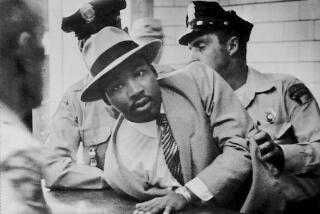Digging for the Real King David in Texts, Ruins
- Share via
The historical image of King David, suggests biblical scholar Steven L. McKenzie, is like a hologram, “a likeness that is fleeting, indistinct and varies according to the spectator’s point of view.” In his “King David: A Biography,” McKenzie attempts to capture and contain the elusive, shape-shifting image of Israel’s preeminent king.
The biblical David is well-known. When he is a youth, his lyre playing eases Saul’s tormented mind; as a brave innocent he defeats the giant Goliath, repelling the entire Philistine army. The gentle shepherd rises to become the inaugural king of a united Israel, combining the tribes of Judah and Israel into a nation and establishing Jerusalem--the City of David--as its capital. David the ruler is less gentle: He’s so driven by passion that he engineers the death of his beloved Bathsheba’s husband. Yet he’s a subtle poet--many of the Psalms are attributed to him.
The Bible, says McKenzie, devotes more space to David than to any other character. “Moses and Jesus rival him for sheer number of pages until you add the Psalms. Then David wins hands down,” the author writes.
But how much of David’s character can be historically substantiated? He is said to have lived about 3,000 years ago, and until recently there was no mention of him in any ancient inscription other than the Bible. In fact, some scholars believe that David the person never existed.
“To what extent is the historical David influenced by theology?” McKenzie asks in his well-researched and eminently accessible biography. “To what extent is the story fictional?” To answer these questions, he uses archeology, textual analysis and biblical scholarship.
He cites, for example, the exciting 1993 discovery of the Tel Dan Stele, an inscribed monument that carries the first extra-biblical occurrence of the phrase “the house of David.” Though the Tel Dan Stele finding does not prove David’s historical existence, it does, according to McKenzie, tip the scales that way.
The author painstakingly deconstructs the biblical David story, examining each piece in relation to what is now known about the times, the characters and the agenda of the biblical writers. He ascertains if each segment fits chronologically, historically and within the social context of the day in the place where it is arranged. McKenzie then rearranges the misplaced pieces into a more realistic shape, resulting in a portrait of David that is less than heroic.
Instead of the gentle ruler we imagine, McKenzie presents a usurping despot prodded on by a desperate grab for power--a man for whom murder is a means to an end, even when his own children are the victims. David’s presumably spectacular kingdom, according to McKenzie, was “much smaller and more parochial” than previously thought. In fact, many beloved aspects of the Bible story are discounted, including the famous slingshot slaying of Goliath: A conflicting Bible verse in one translation of 2 Samuel states that Goliath was killed by a warrior named Elhanan. McKenzie suggests that the story may have been appropriated in order to bring David greater glory.
To his credit, the author explicates the Bible stories with the mindfulness of a detective, paying particular attention to the apologetic nature--” ’apology’ in this sense is a term for a type of literature that defends someone against accusations”--of the narratives, especially the use of “overstress,” as when the biblical writer repeatedly declares David’s innocence in the face of accusations. “The more the author protests, the more we suspect the charge is true,” McKenzie writes.
In addition to altering perceptions of this mythic figure, the biography highlights how apologetic writing has affected Judeo-Christian theology. In the story about Bathsheba, for instance, the biblical writer uses the adultery to justify David’s son Absalom in leading a revolt, thereby excusing David’s policies of taxation and conscription, which may have been the true catalyst. (As the Bible stands, Absalom’s revolt was punishment for David’s affair and the murder of Bathsheba’s husband, Uriah. But the affair, McKenzie hypothesizes, probably took place after the revolt.)
By linking these unrelated events, the biblical writer tries to remove legitimate political cause among David’s subjects for revolt. The effect goes beyond exonerating David’s policies, resulting in a scheme of sin and punishment in which success is equated with God’s approval and failure is a sign of divine retribution. This pattern of cosmic cause-and-effect has influenced theology over the centuries.
The net result of McKenzie’s reconfiguring the ancient biographical puzzle is an absorbing look into who David might have been. Still, the author concedes, much is conjecture. “We can probably never know the real David,” he writes.
But the portrait McKenzie assembles, like a hologram arrested in motion, gives us a realistic likeness of Israel’s most celebrated king.
*
Bernadette Murphy is a critic and fiction writer now completing “Venice Street,” a novel.
More to Read
Sign up for our Book Club newsletter
Get the latest news, events and more from the Los Angeles Times Book Club, and help us get L.A. reading and talking.
You may occasionally receive promotional content from the Los Angeles Times.










